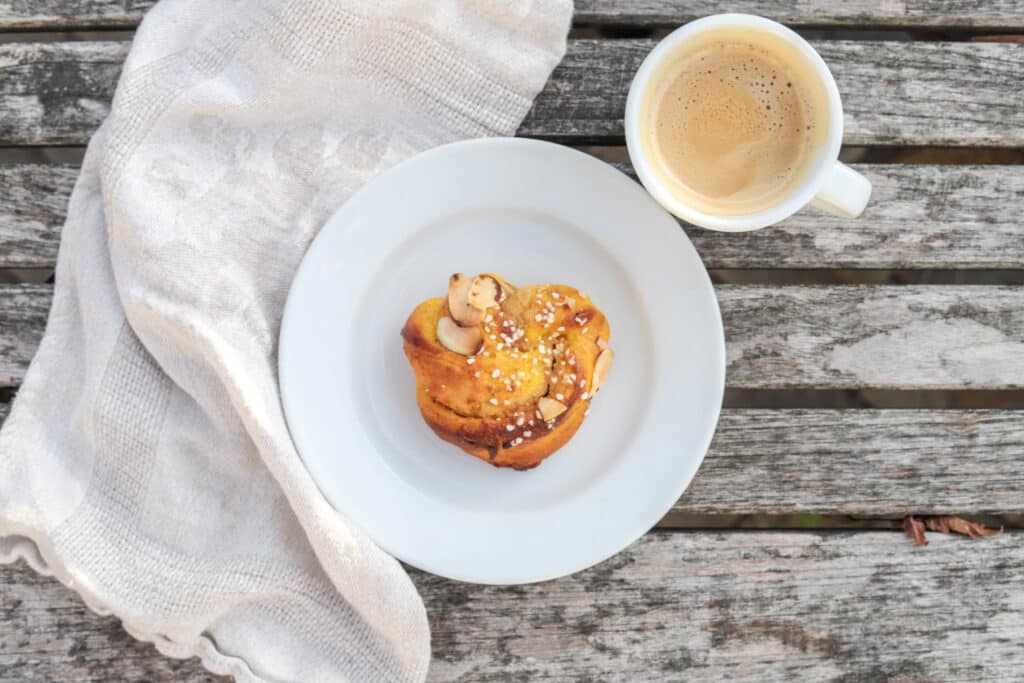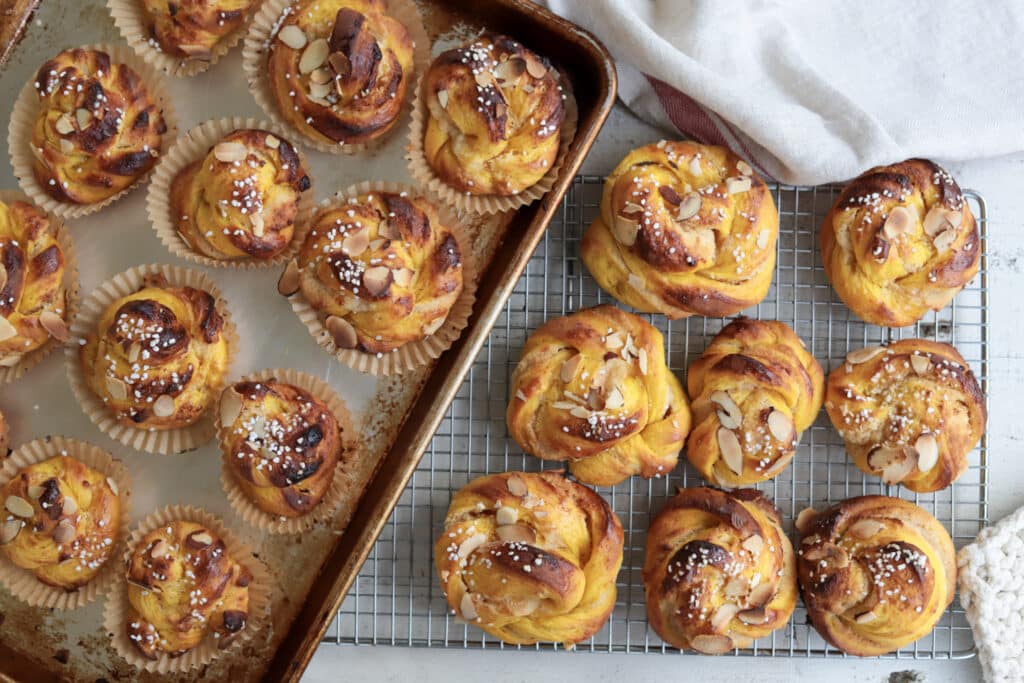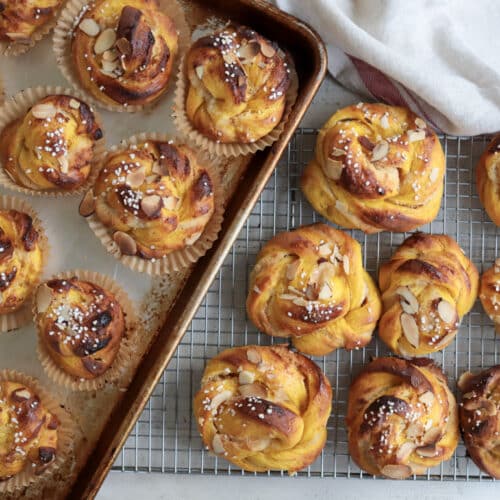
Swedish Saffron Buns with Almond Filling
These Swedish saffron buns are irresistibly delicious with their soft, pillow-like consistency and melt-in-your-mouth almond vanilla paste filling.

Disclosure: Some of the links below are Amazon affiliate links. This means that at no additional cost to you, if you click through and make a purchase I will earn a commission.
Swedish Saffron Buns for St. Lucia Day
Every December, homes across Sweden fill with the delicious scent of golden yellow saffron buns baking in the oven. The most traditional version, the “Lussekat” is eaten on and around December 13 in honor of St. Lucia Day.
A Twist on the Classic Lussekat
The lussekat is a simple saffron bun in the shape of an S and studded with raisins. In full disclosure, I always bake this traditional saffron bun. However, after seeing different variations of this classic on social media, I decided to try something new.
I called my sister Anna and told her about my new baking discovery. As it turned out, she has been making her saffron buns this way for a couple of years now! While the lussekat is delicious and classic, this recipe takes it up a notch by turning the saffron bun into something more like a cardamom bun or “bulle”, except using saffron instead of cardamom and including a vanilla and/or almond filling.
So, how did they turn out?
“These are like fluffy pillows” exclaimed one of my teenage boys.
Indeed, my new recipe, which is an adaptation of the recipe by @fredriksfika and the recipe in my trusty “Vår Kok Bok”, was a success. They are undoubtedly bakery-worthy and almost melt in your mouth.
Like most baked goods, they are best the day they are made. However, freezing them in an airtight bag and reheating them in the microwave is almost as good. And what’s better than having homemade pastries on hand in the freezer?

Ingredients You Need to Make These Swedish Saffron Buns
To make these Swedish Saffron buns you will need the basic baking ingredients of flour, butter, and sugar. However, you will also need some specialty ingredients, including:
- Saffron – Saffron is a spice known for its vibrant yellow-gold color, strong aroma, and unique taste. It’s used in everything from Spanish paella to bouillabaisse to Scandinavian baked goods. It’s expensive, but a little bit goes a long way. This recipe requires 1 gram of saffron, though if you are planning on baking more than one batch or perhaps making paella, you will save money if you buy a 5-gram container such as this one. You can also find smaller, 1-gram containers, in the spice section of most large grocery stores.
- Almond paste – Almond paste is one of my favorite ingredients that I also use in my recipe for Swedish Semlor and this Flourless Almond Cardamom Pear Cake. You could make your own by combining almond flour, powdered sugar, and egg white (google for a recipe), but I save time by buying this one from Odense.
- Yeast – If you are unfamiliar with yeast, there are many options out there. Over the past few years, at my mom’s suggestion, I have been using this one. It’s easy to use in that you can just add it to your flour mixture, you don’t need to activate it with warm liquid (though you can do that if you prefer–it took me a while to get rid of this habit!). The one-pound product provides a lot, but yields excellent results and keeps well in the fridge for a year or even more.
- Swedish Pearl sugar! What is pearl sugar? It’s a coarse sugar, almost like mini pearls, that is a staple in Swedish baking. I often use it on other baked goods too, like Strawberry Oat Muffins and Cardamom Muffins.
Helpful Tools
- Mortar and pestle – for grinding down the saffron
- Kitchen scale – helpful for measuring the flour, but you can also just use measuring cups, being sure to carefully spoon the flour so it doesn’t get packed down
- Parchment paper or paper muffin liners – these are environmentally friendly and slightly larger than standard ones, but you can make these without liners too
- Rolling pin
- Pastry/pizza cutter – for dividing the dough and slicing it into strips
- Pastry brush – for brushing on the egg yolk

Let’s Bake
Once you have read through the recipe and gathered your ingredients, it’s time to bake. I recommend choosing a day to bake when you have plenty of time to let the dough rise. Baking yeast-leavened bread and pastries is a process that generally requires a double rise, so it’s not something that can be rushed. I love to bake on a Sunday when there is not much else going on and almost always start by mid-morning so that we can enjoy the delicious treats in time for afternoon fika!
Other Recipes You Might Like
- Swedish Cardamom Buns
- Swedish Semlor (Cardamom Buns with Almond Paste and Whipped Cream)
- Flourless Pear, Almond, and Cardamom Cake
- Pepparkakor (Swedish Gingersnaps)

Swedish Saffron Buns with Almond Paste
Equipment
- Standing mixer (helpful, but can make these by hand too)
- Mortar and Pestle
- Kitchen scale (helpful)
- 2 Baking sheets
- Parchment paper (or paper muffin cup liners)
- Rolling Pin
- Pizza or pastry wheel/cutter
Ingredients
Buns
- 1 gram saffron
- 1 teaspoon sugar
- 2 cups milk (1%, 2% or whole milk all work; non-dairy milk should also work though I haven't tried it)
- 2 tablespoons instant yeast* see notes below if using active yeast
- 1 cup unsalted butter (2 sticks)
- 1 teaspoon salt
- ¾ cup sugar
- ~6 cups all-purpose flour (840-870 grams — weighing and starting with lower amount will yield best results)
Filling
- 200 grams almond paste
- ½ cup unsalted butter (1 stick)
- 1 teaspoon vanilla extract
Glaze & Topping
- 1 egg, whisked
- ⅓ cup slivered almonds
- ⅓ pearl sugar
Instructions
- Using a mortar and pestle, combine saffron and 1 teaspoon of sugar.
- In a small saucepan over medium heat, warm the milk until it is about 110 degrees Fahrenheit.
- In a large mixing bowl (I use a standing mixer), combine the yeast, warm milk, and the saffron-sugar mixture.
- Next add the softened butter, salt, and ¾ cup sugar. Mix using the dough hook while slowly adding most of the flour. (Save a little flour for rolling out the dough). Work the dough for about 5-10 minutes if you are using a standing electric mixer, or 8-15 minutes if doing it by hand–until the dough is smooth and elastic. (If the dough seems too sticky, add a little more flour, 1 tablespoon at a time.
- Place a clean kitchen towel over the mixing bowl with the dough and then let it rise in a warm, draft-free area until doubled in size, about 40-60 minutes.
- Meanwhile, while the dough rises, make the filling by combining the almond paste and butter, using an electric whisk or food processor.
- Line 2-3 baking sheets with parchment paper.
- Tip the dough onto a floured surface (use leftover flour) and then use a rolling plan to roll it into a large rectangle with the long side facing you.
- Use a spatula to spread the almond mixture over half of the rectangle and then fold the dough onto itself. (You could also spread it evenly over thw whole dough, I often find it easier to do just half!) Gently roll a bit with the rolling pin to seal the two sides of the dough together.
- Use a pizza/pastry wheel/cutter to cut 24-36 thin strips of dough. Pick up one strip at a time and twist it into a spiral. Then, hold one end still while looping the other end around to form a twisty knot-like structure. Tuck the loose ends underneath. Place each saffron bun onto the baking sheet.
- Cover the baking sheets with the saffron buns with clean tea towels and let rise for another 30-45 minutes.
- Meanwhile, preheat the oven to 425 degrees Fahrenheit and make the glaze by whisking the egg in a small bowl.
- Brush each bun with the whisked egg and then sprinkle with pearl sugar and sliced almonds. Bake in the oven for 10-12 minutes or until golden.
- Transfer to a wire rack to let cool. (And be sure to try one while they are still warm from the oven!)
Leave a Reply